What the ... ?
Do you like detective stories? If you do, I have a “who-done-it” that could leave you going “what the … ?”
Andy Boone, retired section chief with the South Carolina Forestry Commission, shared a story about sugarberry decline published in the November issue of The Forestry Source. Not sure how many of you are familiar with sugarberry (Celtis larvigata), a native bottomland tree species. It’s not a common landscape ornamental and shade tree species. But, you’ll be surprised how frequently you can encounter sugarberry trees along property lines in the cities of the Southeast, and confuse them with hackberry (Celtis occidentalis). The sugarberry has limited commercial value, so it’s often considered a trash tree.
Andy started to get calls about dying sugarberry trees in 2009. The affected trees first turned yellow, then died after all the leaves fell off. The area affected was first confined to neighborhoods around Columbia, South Carolina. Reports continued to come in over the years. The decline was reported in North Augusta, South Carolina, and Augusta, Georgia, in 2015.
When sugarberry trees started to die at the famous Augusta National Golf Club, people started to pay more attention. As many as 50% of infected trees at a study site in Georgia died within a year. Municipalities and homeowners are spending tens of thousands of dollars each year to remove dead and dying trees.
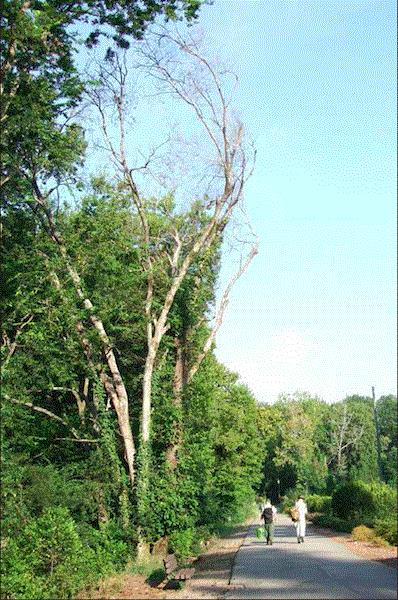
A declining sugarberry tree. (Photo credit: Michael Ulyshen, USDA Forest Service)
Beginning in 2011, a group from the U.S. Forest Service, South Carolina and Georgia Forestry Commissions, universities and municipalities began to work together to find the smoking gun. Is it drought, disease, insects or a combination of these problems? Nah, I’m not going to give the ending away. Read this story to find out.

Ventigra crop safety summary
Ventigra (afidopyropen) is a new Group 9D insecticide introduced by BASF in March 2019. Ventigra can be used on indoor and outdoor ornamentals, as well as vegetable transplants and non-fruiting fruit and nut trees, for aphid, whitefly, mealybug and scale insect management.
From 2015 through 2019, IR-4 Project and its collaborating researchers completed 106 crop safety trials, covering 42 plant genera or species. Ventigra was applied as three foliar sprays, at 14-day intervals, at 7, 14 and 28 fl. oz. per 100 gallons. (The label rates of Ventigra are 1.4, 4.8 and 7 fl. oz. per 100 gallons.) No plant genera or species exhibited significant crop injury at the tested rates. Click here to see the list of plant species tested.

Currently, the Ventigra label lists Coleus Rustic Orange, weeping fig, poinsettia at bract formation, and flowering impatiens and petunia as sensitive. It’s a good idea to run a small-scale test for phytotoxicity on your own since BASF and IR-4 cannot cover all the plant species and cultivars on the market. Spray a few plants with Ventigra at your desirable application rate and method, and keep an eye out for any burn, discoloration or deformation for a few days after the treatment.
Downy mildew research summary
IR-4 Project published a result summary of a series of research projects on downy mildews (impatiens, cucurbit, basil and hops). The APHIS-funded research was conducted by a team of researchers from six universities and USDA ARS. The projects studied the biology and epidemiology of impatiens and cucurbit downy mildews, developed detection and diagnostic methods for various downy mildew species, identified management strategies and disseminated information to the stakeholders.
These research projects helped to deepen our understanding of downy mildew epidemiology and management. Without going into detail, here is some of the important information gleaned from the summary:
-
Impatiens downy mildew overwinters as oospores (thick-walled resting spores that stay in the environment for years) in the stems of common garden impatiens and seeds of balsam impatiens. These oospores can be produced through self-fertilization.
-
Impatiens downy mildew infection is more severe in lower temperatures and with prolonged leaf wetness. Oospore germination is enhanced by exposure to 32F. Results suggest that growing crops at higher temperatures (above 77F) and reducing the time the foliage remains wet (through modifications to irrigation practices and ventilation) can reduce downy mildew incidence.
-
Several impatiens and cucurbit species can serve as alternative hosts and reservoirs of the impatiens and cucurbit downy mildews, allowing the pathogen population to persist in the environment.
-
Detection and collection of downy mildew populations can be improved with molecular and genomic tools. Through this research, several new downy mildew species were identified in cucurbits.
-
Pockets of mefenoxam and fluopicolide resistance have been identified in impatiens downy mildew populations, highlighting the need for fungicide rotation. Additional efficacy data is included in the summary.
There is so much information in the 167-page report that I’d be insane if I tried to summarize them all in this newsletter. Links to extension publications and factsheets are also included in the summary. Get a copy by clicking here. Keep a copy by your bedside and read at your leisure.

Mealybugs, oh my!
Y’all know I love mealybugs, right? I’ve declared that in public on multiple occasions. Richard Criley of the University of Hawaii picked up on that. He graciously shared a couple of pictures of papaya mealybug infesting plumeria from a huge infestation Hawaii suffered a few years ago. In Richard’s own words, “Insect pressure was so great that some trees sloughed off their bark, growing points and leaves were malformed, and even seed pods developed distortions.” Yikes!
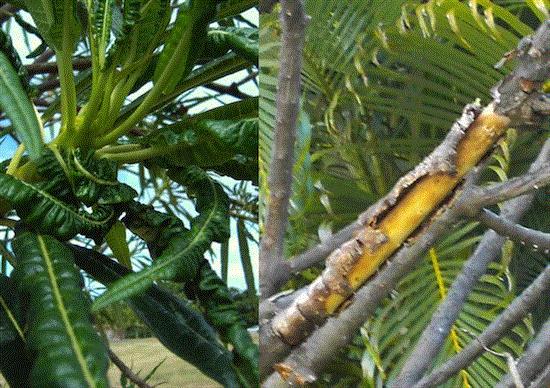
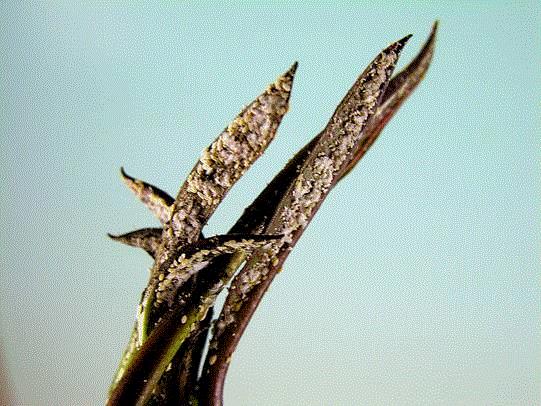
Papaya mealybug on plumeria. (Photo credit: Richard Criley, University of Hawaii)
I’m not one to be outdone. So, without further ado, allow me to introduce to y’all the first edition of “JC’s Horror Picture Show,” coming straight from JC’s skeleton closet. Enjoy!
Scaring you with pictures of bad infestations without telling you how to manage them is plain mean, in my book. I penned an article on mealybug management for GrowerTalks a couple of years ago. The article summarized research data on insecticide efficacy, as well as lessons I’ve learned after working with mealybugs for 20 years. Find the full article by clicking HERE.
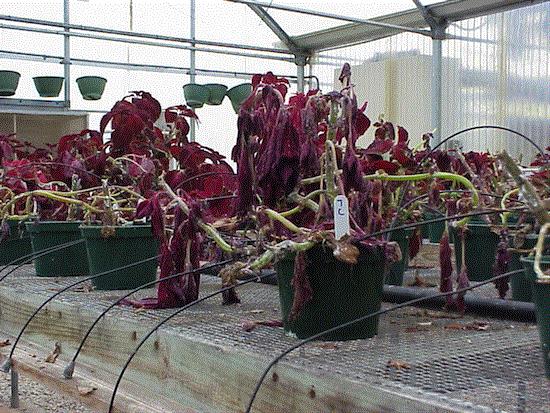
Madeira mealybugs killed my coleus! (Photo credit: JC Chong)
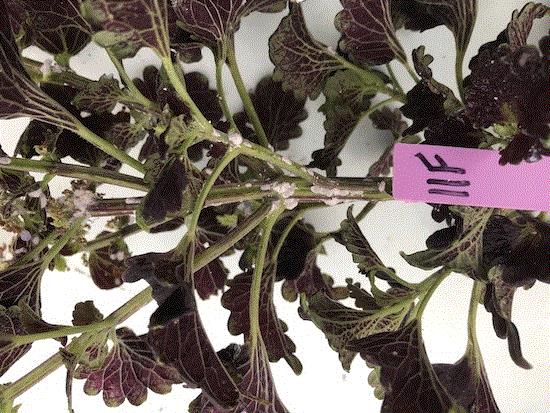
This treatment did not work on citrus mealybug. (Photo credit: JC Chong)
A few of these important lessons are:
-
Mealybugs have to come from somewhere, and that “somewhere” may be the cuttings you’ve just bought, those special stock plants you hid away in the back corner, or the oxalis under your benches. Make sure your plant materials, crops or weeds, are free of mealybugs.
-
Target crawlers or young nymphs because they don't have a thick layer of water-repelling wax.
-
Some insecticides work better than others. Check out the article for some of my favorites.
-
Adding a spreader-sticker type adjuvant and using a high application volume can increase efficacy.
-
A spray works better and faster than a drench. If you already have an infestation, hit them hard and repeatedly with sprays. If you are trying to protect stock plants and plant species that always get mealybugs, or if you have recurring mealybug problems, it’s worth considering a drench as a preventive treatment.
-
The best solution for heavily infested plants? The trash can.
I love mealybugs. I love to find out what makes them tick, and what kills them. My wife and her dog often complain, loudly, or through those big brown googly eyes, that I don't love them as much as I love the mealybugs. But, really, I don't think they want me to love them the way I love mealybugs.






See y'all next time!

JC Chong
Professor of Entomology at Clemson University
This e-mail received by 22,731 subscribers like you!
If you're interested in advertising on PestTalks contact Kim Brown ASAP!